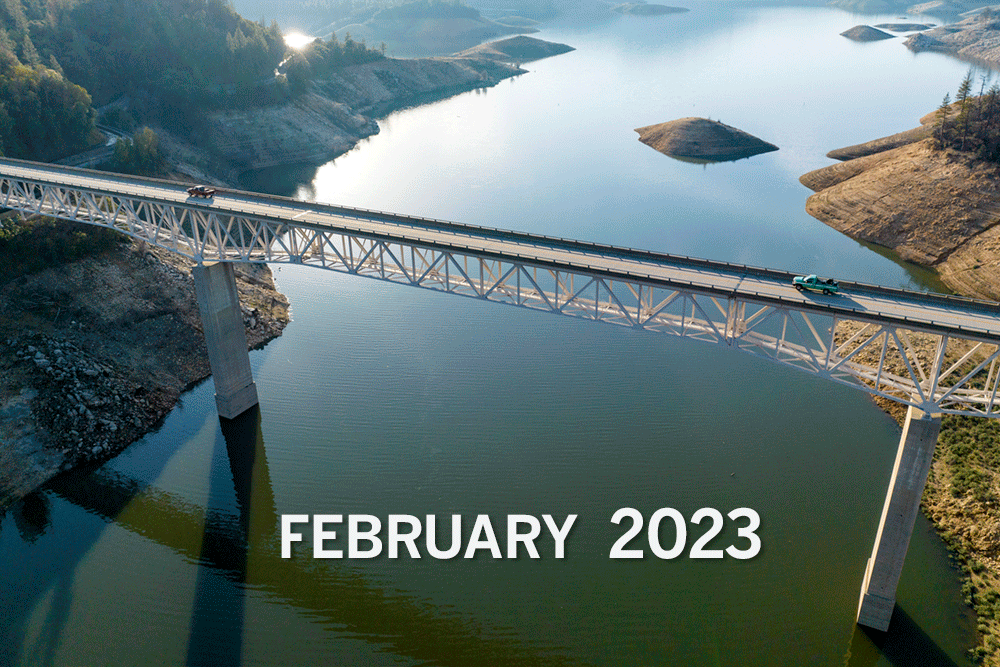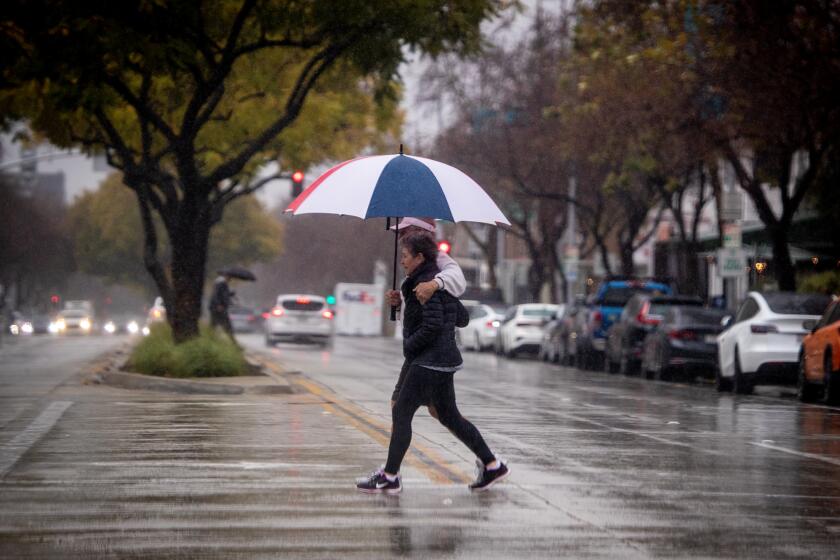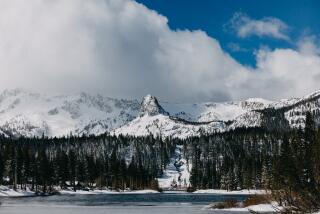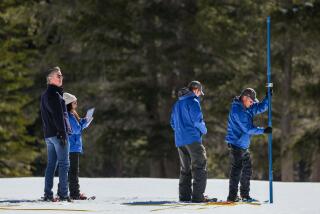California’s snowpack is approaching an all-time record, with more on the way

- Share via
A remarkably wet winter has resulted in some of the deepest snowpack California has ever recorded, providing considerable drought relief and a glimmer of hope for the state’s strained water supply.
Statewide snowpack Friday measured 190% of normal, hovering just below a record set in the winter of 1982-83, officials with the Department of Water Resources said during the third snow survey of the season. The surveys are conducted monthly during the winter at Phillips Station near South Lake Tahoe.
In the Southern Sierra, snowpack reached 231% of average for the date, nearing the region’s benchmark of 263% set in 1969 and trending ahead of the winter of 1983.
With just one month remaining in the state’s traditional rainy season, officials are now voicing cautious optimism over the state’s hydrologic prospects.
“We have either at- or nearing-record snowpack in California as a result of our snow survey today, with other storms on the horizon and more time left in our traditional rainy season,” said DWR Director Karla Nemeth. “We could not be more fortunate to have had this kind of precipitation after three very punishing years of dry and drought conditions.”
The snow-capped Sierra Nevada and the Santa Monica Mountains north of Malibu are among the areas of California no longer considered to be in drought.
California’s snowpack typically supplies about a third of California’s water supply, and the last three years have been the driest on record, triggering a statewide drought emergency and unprecedented water restrictions.
“I know the question of the day is going to be, ‘does this mean that California is officially out of the drought,’ and there is more work that needs to be done to help us understand where things are headed relative to this terrific snowpack and the water supply that’s available to manage for people and the environment,” Nemeth said.
She noted that snowpack is variable across the state, and that conditions in some parts of Northern California are just approaching average. “It continues to be premature to describe that part of the state as out of drought, but it is, without question, terrific information for Californians,” she said.
In October 2021, Gov. Gavin Newsom issued a statewide drought emergency declaration that included calls for residents to voluntarily reduce water use by 15%. In the weeks and months that followed, several regional agencies ordered stricter regulations, including mandatory one- and two-day a week outdoor watering limits for millions of people in Southern California, most of which remain in place.
Gregory Pierce, co-director of the Luskin Center for Innovation at UCLA, said it probably makes sense to consider easing some of the most extreme restrictions, but that conservation efforts should continue indefinitely.
“This precipitation is great, and it does mean we can let up a little bit on some of the most radical things we were doing — and particularly we can breathe a little bit easier for communities that were literally running out of water or about to run out of water,” Pierce said. “But we also can’t let up at all when it comes to conservation, long-term measures and major investments in recycling, large-scale stormwater-to-groundwater capture and other technologies.”
“We bought ourselves some more time, so we don’t need to be in that hyper-emergency, but we’re always in a drought,” he added.
With the rest of the wet season uncertain, officials urge California to keep conserving water.
Water experts say it will take more than one wet winter to make up for years of deficits, especially when it comes to groundwater. They note that much of the American Southwest continues to suffer its driest two-decade period in more than 1,200 years.
California’s wet winter has driven renewed calls for improved stormwater capture efforts at local and state levels, with many decrying the amount of water channeled out to the ocean during storms. Officials said the need to prepare for floods and drought at the same time has only gotten worse as climate change drives weather whiplash, or swings between bouts of extreme weather.
In fact, the potential for another atmospheric river storm to develop later in March has raised the spectre of flood risk should a warm rain-on-snow event occur, said Sean De Guzman, manager of snow surveys with the DWR.
“That’s something we’re keeping an eye on throughout the weekend,” he said. “That storm is generating a lot of interest, but at this point, it needs to be really warm to actually melt a lot of that snow.”
David Rizzardo, the DWR’s hydrology section manager, said snowpack at 5,000-foot elevations or lower is likely to melt sooner, but that snow at higher elevations in the Sierra remains extremely cold and won’t melt soon. Officials are already preparing for when the abundant snow at those higher elevations comes down, he said.
“It’s really at this point, when is the weather going to shift in such a way that we go from building snowpack to melting snowpack,” he said.
He and other DWR officials said that many reservoirs — while much healthier after the winter storms — still have some room to be filled. Lake Shasta, the state’s largest reservoir, was at 61% capacity as of Friday, according to state data.
With the possibility of a warm atmospheric river hitting California this month, officials now worry about preserving precious Sierra snowpack.
Still, there is no denying the record-setting winter made a dent in drought conditions. The U.S. Drought Monitor on Thursday moved more than half of the state out of its four categories of drought, including about 34% of California now classified as “abnormally dry” and 17% as out of drought completely.
In February, Newsom issued an executive order directing state agencies to review and provide recommendations on the current drought response, “including possibly even terminating specific emergency provisions that are no longer needed,” De Guzman said. “But that’s not really until we have a better clarity of what the hydrologic conditions are for the year once we get toward April.”
Officials also continued to emphasize that groundwater has been depleted by climate change and overpumping, including some basins that could take years, decades or even longer to refill.
“We have areas like the Central Valley and San Joaquin Valley in particular — where there is really just a massive deficit in storage over a long period of time in groundwater basins — and this is not something that’s going to change in any kind of rapid fashion,” said DWR drought manager Jeanine Jones.
Pierce, of UCLA, noted that the Colorado River — a major source of water for Southern California — also remains dangerously depleted. And with long-term trends still pointing to a hotter, drier California, now is no time to “let off the pedal,” he said.
“We can’t let up at all on the medium- and long-term [efforts], because this is going to be an anomalously positive year,” he said. “And who knows what the next five to 10 years will bring. We could be right back in the same situation that we were in two months ago, and two years ago.”
More to Read
Sign up for Essential California
The most important California stories and recommendations in your inbox every morning.
You may occasionally receive promotional content from the Los Angeles Times.














